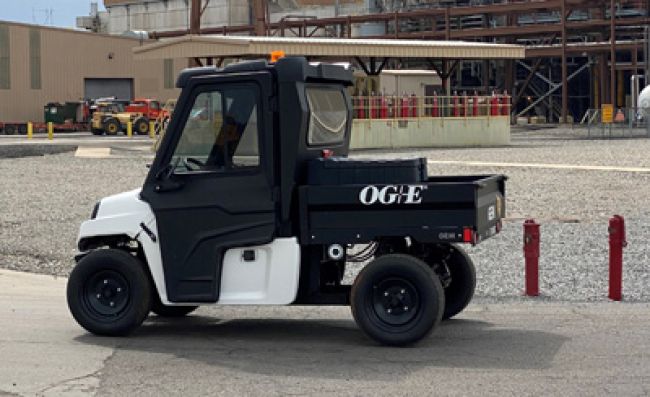
The State of UTV Electrification
There is at least one obvious reason for an electric utility to move toward adopting electric-powered vehicles into its fleet.
“We’re using our own product,” said Paul Jefferson, senior fleet manager for Oklahoma Gas and Electric, which serves more than 858,000 customers across 30,000 square miles in Oklahoma and western Arkansas.
Another reason for the move? “[The vehicles] are lower maintenance,” Jefferson said. “You don’t have to change the oil and do other types of maintenance as with gas engines.”
His fleet includes 101 UTVs, 58 of which are powered by electricity; the remainder are due to be replaced by electric UTVs in the coming years.
OG&E had long wanted to move to electric UTVs, Jefferson said, but it took a while for the industry to catch up. “Four years ago, we started adding electric UTV carts. Prior to that, you could buy a golf cart, but there weren’t really robust UTV options out there.”
Alternative-fuel vehicle innovations are driven in part by sustainability mandates, “but most of the time, they still need to make sense financially and do the same job as the vehicle they were replacing: delivering on the payload and range,” said Nick Snidarich, product manager for Polaris Commercial (https://commercial.polaris.com). Polaris offers an electric passenger vehicle, the GEM, and a recently introduced electric powersport vehicle, the RANGER. The company’s PRO XD, a heavy-duty work UTV, is not yet electrified; Polaris currently offers a gas-powered version.
Because of consumer interest as well as the continued introduction of alternative-fuel vehicle innovations to the marketplace, even those manufacturers not yet offering electric-powered UTVs are exploring the idea. Patrick Hébert, product manager for PRINOTH (www.prinoth.com), said he sees diesel as the best solution for the short term, but he also noted that, “Nevertheless, it is important to mention that electric propulsion and battery technology are already a reality for smaller machines due to the lower power demands. PRINOTH is actively monitoring the technology available, and in order to make it a reality, it is mandatory for us to find a solution that allows the vehicle to be recharged in extreme off-road remote locations and that can last safely through a whole workday.”
Use Cases
There are distinct advantages and disadvantages to electric utility vehicles, including UTVs. Snidarich points to applications that require “people, equipment or other cargo to be moved around campuses, cities and job sites. Their near-silent operation is critical when any added noise contributes to a reduction in safety, or when hearing is needed to identify issues. For example, rail workers use electric UTVs so they can still listen for a whistling sound or hissing from the train’s hydraulic brakes that signals repair is needed.”
There are times, though, when an electric UTV may fall short of its gas-powered counterpart, Jefferson said. “If you try to share one cart among three shifts and continuously use it, sometimes there’s not enough time to charge it up, even though it has a 45-mile range.” Rather than switch to gas, however, he’s found it just as efficient to add another electric UTV.
Most of OG&E’s UTVs are in use at power plants as transportation on the property. They are spec’d to include a bed, where tools and small equipment can be stored.
Looking Ahead
When asked if he had a wish list of future improvements to electric UTVs, Jefferson said he would like to see manufacturers replace AGM batteries with lithium-ion. It’s something he knows manufacturers are working on, but he hopes to see the change happen soon.
PRINOTH currently offers a hybrid snow groomer as well as a new, fully electric snow groomer. Hébert believes that the technology could eventually make its way to the company’s PANTHER product line, which “shares a very similar powertrain architecture with snow groomers.” But first, the demand must mature, he said.
Hébert also said he believes hybrid innovations will be the way to go in the short term, first with implements, then the hybrid drive. Eventually, he envisions a fully electric crawler. “The challenge right now with this concept is the important amount of energy that needs to be stored inside batteries for some applications – digger derrick and dump-box applications as examples. The battery technology is not mature enough yet for such applications; therefore, usage of fuel cell systems may still be required to be able to last a full working shift for such applications.”
About the Author: Sandy Smith is a freelance writer and editor based in Nashville, Tennessee.
*****
Considerations Before You Buy
Are you thinking about adding all-electric UTVs to your fleet? If so, there are some things to consider before you buy, including:
- Availability of charging infrastructure. This is an important consideration but not necessarily a deal-breaker. Nick Snidarich, product manager for Polaris Commercial, referenced Sandia National Laboratories, which adapted the Polaris GEM vehicle by adding solar panels to its top. “Anytime the vehicles were left outside in the sun, they recharged themselves without needing to be plugged in.”
- The terrain the UTVs will be used on, which may require four-wheel-drive, according to Paul Jefferson, senior fleet manager for Oklahoma Gas and Electric. The utility’s electric UTVs are mostly used on power plant grounds and do not include four-wheel-drive.
- What the vehicles will be used for. Jefferson said electric UTVs have a distinct advantage over gas combustion engines for indoor use.

